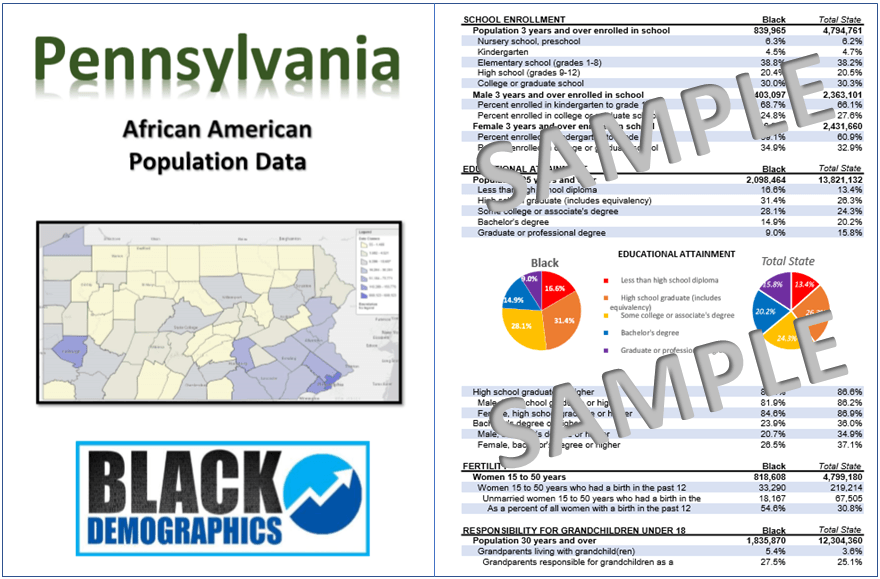Pennsylvania
According to 2020 census data, the Black population in Pennsylvania was 1,423,169, accounting for 11% of the state’s total population. This includes those who identify as Black alone. For those who identify as Black in combination with one or more races the population is 1,655,034 or 13% of the population of Pennsylvania.
| State Data | Black Alone | Total State |
| Total population (ACS estimate) | 1,423,169 | 12,964,056 |
| Median household income | $42,199 | $68,957 |
| Bachelor’s degree or higher | 21.9% | 34.5% |
| Family poverty rate | 21.4% | 8.3% |
| Percentage households Married-couple families | 22.3% | 46.9% |
| Homeowner rate | 44.7% | 69.9% |
Source: U.S. Census Bureau, 2021 American Community Survey 1-Year Estimates
GROWTH
Between 1990 and 2020, the Black population in Pennsylvania grew from approximately 1 million to over 1.4 million. This growth has been driven by both natural increase and in-migration from other states. As the African American population continues to grow, it contributes to the political, economic, and cultural landscape of Pennsylvania.
LOCATIONS AND NEIGHBORHOODS
A substantial proportion of Pennsylvania’s African American population resides in the Philadelphia metropolitan area, where they make up around 44% of the city’s population. Other urban areas, such as Pittsburgh, Harrisburg, and Allentown, also host significant Black populations. Additionally, there are numerous Black residents living in smaller cities, towns, and rural areas across the state.
MIGRATION
Pennsylvania experienced an influx of African Americans during the Great Migration in the early 20th century. Black residents from the South, including states like Georgia, Alabama, and Mississippi, migrated to Pennsylvania in search of better opportunities in the industrial North. Cities like Philadelphia and Pittsburgh offered jobs in steel mills, manufacturing plants, and other industries.
Socioeconomic Conditions Historically, the Black population in Pennsylvania has faced socioeconomic challenges, including discrimination, segregation, and limited access to quality education and housing. While progress has been made, disparities still exist in areas such as income, unemployment rates, and homeownership. However, Black residents have made significant strides in local and state politics, as well as in entrepreneurship, entertainment, and arts, contributing to the cultural vibrancy of the state.
HISTORY
The presence of African Americans in Pennsylvania dates back to the 1600s when the region was a British colony. At the time, the Black population was primarily composed of enslaved Africans who were brought to the area to work on farms and in households. By the time of the American Revolution, Pennsylvania had the largest free Black population in the country, with many Black residents participating in the struggle for independence. The state was also an important center of the abolitionist movement, with notable figures like Richard Allen, Absalom Jones, and Robert Purvis advocating for the end of slavery.
Following the Civil War and the subsequent emancipation of enslaved people, Pennsylvania’s Black population continued to grow. Many African Americans remained in the state, working in industries such as steel manufacturing, transportation, and domestic services. The Great Migration of the early 20th century brought a large number of Black residents to Pennsylvania, further shaping the state’s demographic landscape.
Get the Complete Pennsylvania African American Population Report


